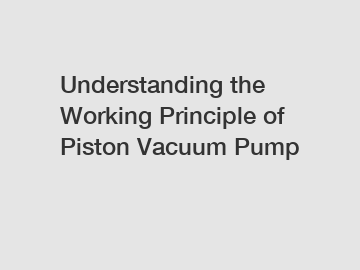Mar. 10, 2024
Energy
### Understanding the Working Principle of Piston Vacuum Pump.
**1. What is a piston vacuum pump?**.
A piston vacuum pump is a type of positive displacement pump used to create vacuum by moving a piston within a cylinder. It is commonly used in applications where a high level of vacuum is required, such as in laboratories, chemical processing, and industrial manufacturing.

**2. How does a piston vacuum pump work?**.
- The piston vacuum pump consists of a cylinder with a piston that moves up and down within it. .
- When the piston moves downwards, it creates a vacuum in the cylinder by expanding the volume of the space above it. This causes air or gas to be drawn into the cylinder through an inlet valve.
- As the piston moves upwards, the volume of the space above it decreases, compressing the air or gas. An outlet valve opens to allow the compressed air or gas to be expelled from the cylinder. .
- This cycle of suction and compression continues repetitively, creating a steady vacuum within the pump.
**3. What are the advantages of a piston vacuum pump?**.
- Piston vacuum pumps are capable of generating a high level of vacuum, making them suitable for applications that require strong suction power.
- They are also known for their reliability and durability, requiring minimal maintenance compared to other types of vacuum pumps.
- Piston vacuum pumps can handle a wide range of gases and vapors, making them versatile for various industrial and scientific applications.
**4. What are the limitations of a piston vacuum pump?**.
- Piston vacuum pumps can be noisy during operation due to the mechanical movement of the piston within the cylinder.
- They are not suitable for applications requiring continuous, uninterrupted operation, as the cycling of the piston can generate heat and cause wear over time.
- Piston vacuum pumps may require periodic adjustments to maintain optimal performance, particularly in high-pressure or high-temperature environments.
In conclusion, a piston vacuum pump operates by utilizing the movement of a piston within a cylinder to create suction and compression cycles, ultimately generating a vacuum. While piston vacuum pumps offer advantages such as high vacuum levels, reliability, and versatility, they also have limitations such as noise, potential for wear, and maintenance requirements. Overall, understanding the working principle of a piston vacuum pump is essential for determining its suitability for specific applications.
For more information, please visit piston pumps work, water piston pump works, piston pump how it works.
If you are interested in sending in a Guest Blogger Submission,welcome to write for us!
All Comments ( 0 )